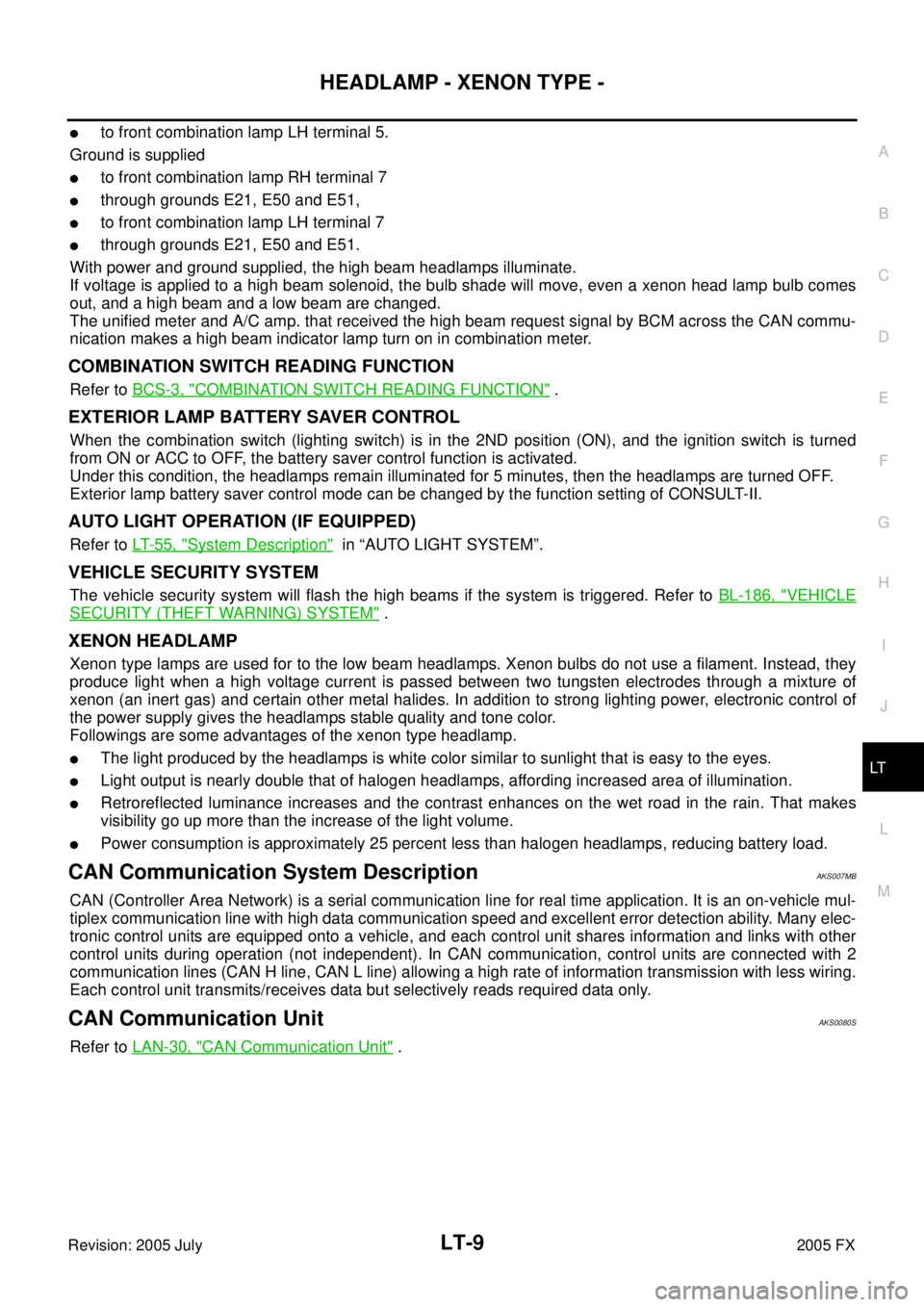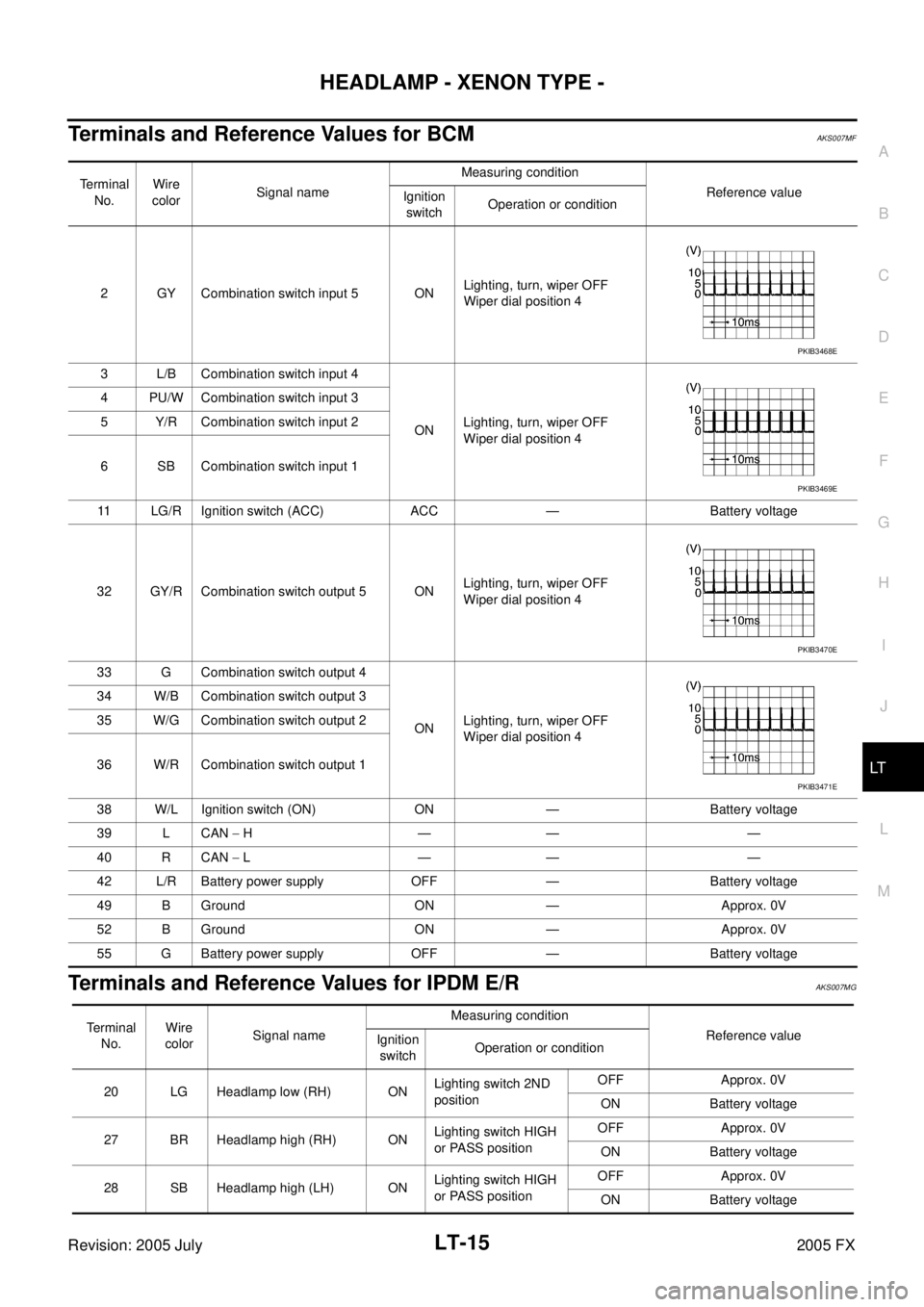Page 3897 of 4731

LT-8
HEADLAMP - XENON TYPE -
Revision: 2005 July 2005 FX
With ignition switch in ON or START position, power is supplied
�to ignition relay, located in IPDM E/R, from battery direct
�through 15A fuse [No. 1, located in fuse block (J/B)]
�to BCM terminal 38,
�through 10A fuse [No. 14, located in fuse block (J/B)]
�to combination meter terminal 7.
With ignition switch in ACC or ON position, power is supplied
�through 10A fuse [No. 6, located in fuse block (J/B)]
�to BCM terminal 11.
Ground is supplied
�to BCM terminals 49 and 52
�through grounds M35, M45 and M85,
�to IPDM E/R terminals 38 and 60
�through grounds E21, E50 and E51,
�to combination meter terminals 5, 6 and 15
�through grounds M35, M45 and M85.
HEADLAMP OPERATION
Low Beam Operation
With the lighting switch in the 2ND position, the BCM receives input signal requesting the headlamps to illumi-
nate. This input signal is communicated to the IPDM E/R across the CAN communication lines. The CPU
located in the IPDM E/R controls the headlamp low relay coil, which when energized, directs power
�through 15A fuse (No. 76, located in IPDM E/R)
�through IPDM E/R terminal 20
�to front combination lamp RH terminal 6,
�through 15A fuse (No. 86, located in IPDM E/R)
�through IPDM E/R terminal 30
�to front combination lamp LH terminal 6.
Ground is supplied
�to front combination lamp RH terminal 7
�through grounds E21, E50 and E51,
�to front combination lamp LH terminal 7
�through grounds E21, E50 and E51.
With power and ground supplied, low beam headlamps illuminate.
High Beam Operation/Flash-to-Pass Operation
With the lighting switch in the 2ND position and placed in the HIGH or PASS position, the BCM receives input
signal requesting the headlamp high beams to illuminate. This input signal is communicated to the IPDM E/R
across the CAN communication lines. The CPU located in the IPDM E/R controls the headlamp high relay coil
and low relay coil, which when energized, directs power
�through 15A fuse (No. 76, located in IPDM E/R)
�through IPDM E/R terminal 20
�to front combination lamp RH terminal 6,
�through 15A fuse (No. 86, located in IPDM E/R)
�through IPDM E/R terminal 30
�to front combination lamp LH terminal 6,
�through 10A fuse (No. 72, located in IPDM E/R)
�through IPDM E/R terminal 27
�to front combination lamp RH terminal 5,
�through 10A fuse (No. 74, located in IPDM E/R)
�through IPDM E/R terminal 28
Page 3898 of 4731

HEADLAMP - XENON TYPE - LT-9
C
D E
F
G H
I
J
L
M A
B
LT
Revision: 2005 July 2005 FX
�to front combination lamp LH terminal 5.
Ground is supplied
�to front combination lamp RH terminal 7
�through grounds E21, E50 and E51,
�to front combination lamp LH terminal 7
�through grounds E21, E50 and E51.
With power and ground supplied, the high beam headlamps illuminate.
If voltage is applied to a high beam solenoid, the bulb shade will move, even a xenon head lamp bulb comes
out, and a high beam and a low beam are changed.
The unified meter and A/C amp. that received the high beam request signal by BCM across the CAN commu-
nication makes a high beam indicator lamp turn on in combination meter.
COMBINATION SWITCH READING FUNCTION
Refer to BCS-3, "COMBINATION SWITCH READING FUNCTION" .
EXTERIOR LAMP BATTERY SAVER CONTROL
When the combination switch (lighting switch) is in the 2ND position (ON), and the ignition switch is turned
from ON or ACC to OFF, the battery saver control function is activated.
Under this condition, the headlamps remain illuminated for 5 minutes, then the headlamps are turned OFF.
Exterior lamp battery saver control mode can be changed by the function setting of CONSULT-II.
AUTO LIGHT OPERATION (IF EQUIPPED)
Refer to LT- 5 5 , "System Description" in “AUTO LIGHT SYSTEM”.
VEHICLE SECURITY SYSTEM
The vehicle security system will flash the high beams if the system is triggered. Refer to BL-186, "VEHICLE
SECURITY (THEFT WARNING) SYSTEM" .
XENON HEADLAMP
Xenon type lamps are used for to the low beam headlamps. Xenon bulbs do not use a filament. Instead, they
produce light when a high voltage current is passed between two tungsten electrodes through a mixture of
xenon (an inert gas) and certain other metal halides. In addition to strong lighting power, electronic control of
the power supply gives the headlamps stable quality and tone color.
Followings are some advantages of the xenon type headlamp.
�The light produced by the headlamps is white color similar to sunlight that is easy to the eyes.
�Light output is nearly double that of halogen headlamps, affording increased area of illumination.
�Retroreflected luminance increases and the contrast enhances on the wet road in the rain. That makes
visibility go up more than the increase of the light volume.
�Power consumption is approximately 25 percent less than halogen headlamps, reducing battery load.
CAN Communication System DescriptionAKS007MB
CAN (Controller Area Network) is a serial communication line for real time application. It is an on-vehicle mul-
tiplex communication line with high data communication speed and excellent error detection ability. Many elec-
tronic control units are equipped onto a vehicle, and each control unit shares information and links with other
control units during operation (not independent). In CAN communication, control units are connected with 2
communication lines (CAN H line, CAN L line) allowing a high rate of information transmission with less wiring.
Each control unit transmits/receives data but selectively reads required data only.
CAN Communication UnitAKS0080S
Refer to LAN-30, "CAN Communication Unit" .
Page 3899 of 4731
LT-10
HEADLAMP - XENON TYPE -
Revision: 2005 July 2005 FX
SchematicAKS007MD
TKWM0601E
Page 3900 of 4731
HEADLAMP - XENON TYPE - LT-11
C
D E
F
G H
I
J
L
M A
B
LT
Revision: 2005 July 2005 FX
Wiring Diagram — H/LAMP —AKS007ME
TKWM0815E
Page 3901 of 4731
LT-12
HEADLAMP - XENON TYPE -
Revision: 2005 July 2005 FX
TKWM0603E
Page 3902 of 4731
HEADLAMP - XENON TYPE - LT-13
C
D E
F
G H
I
J
L
M A
B
LT
Revision: 2005 July 2005 FX
TKWM0604E
Page 3903 of 4731
LT-14
HEADLAMP - XENON TYPE -
Revision: 2005 July 2005 FX
TKWM0605E
Page 3904 of 4731

HEADLAMP - XENON TYPE - LT-15
C
D E
F
G H
I
J
L
M A
B
LT
Revision: 2005 July 2005 FX
Terminals and Reference Values for BCMAKS007MF
Terminals and Reference Values for IPDM E/RAKS007MG
Terminal
No. Wire
color Signal name Measuring condition
Reference value
Ignition
switch Operation or condition
2 GY Combination switch input 5 ON Lighting, turn, wiper OFF
Wiper dial position 4
3 L/B Combination switch input 4 ON Lighting, turn, wiper OFF
Wiper dial position 4
4 PU/W Combination switch input 3
5 Y/R Combination switch input 2
6 SB Combination switch input 1
11 LG/R Ignition switch (ACC) ACC — Battery voltage
32 GY/R Combination switch output 5 ON Lighting, turn, wiper OFF
Wiper dial position 4
33 G Combination switch output 4 ON Lighting, turn, wiper OFF
Wiper dial position 4
34 W/B Combination switch output 3
35 W/G Combination switch output 2
36 W/R Combination switch output 1
38 W/L Ignition switch (ON) ON — Battery voltage
39 L CAN − H—— —
40 R CAN − L—— —
42 L/R Battery power supply OFF — Battery voltage
49 B Ground ON — Approx. 0V
52 B Ground ON — Approx. 0V
55 G Battery power supply OFF — Battery voltage
PKIB3468E
PKIB3469E
PKIB3470E
PKIB3471E
Te r m i n a l No. Wire
color Signal name Measuring condition
Reference value
Ignition
switch Operation or condition
20 LG Headlamp low (RH) ON Lighting switch 2ND
position OFF Approx. 0V
ON Battery voltage
27 BR Headlamp high (RH) ON Lighting switch HIGH
or PASS position OFF Approx. 0V
ON Battery voltage
28 SB Headlamp high (LH) ON Lighting switch HIGH
or PASS position OFF Approx. 0V
ON Battery voltage